动名词作主语和宾语
- 格式:doc
- 大小:40.50 KB
- 文档页数:2

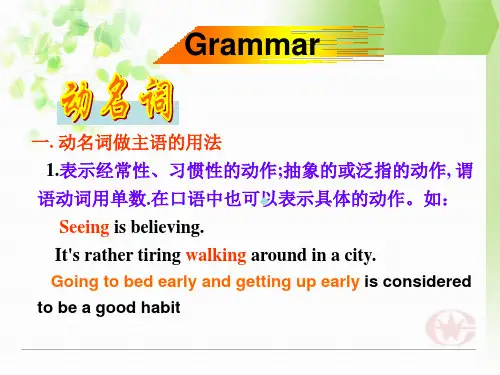
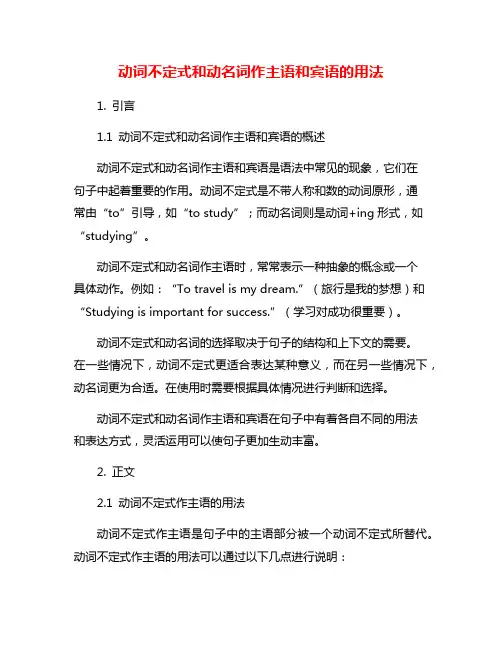
动词不定式和动名词作主语和宾语的用法1. 引言1.1 动词不定式和动名词作主语和宾语的概述动词不定式和动名词作主语和宾语是语法中常见的现象,它们在句子中起着重要的作用。
动词不定式是不带人称和数的动词原形,通常由“to”引导,如“to study”;而动名词则是动词+ing形式,如“studying”。
动词不定式和动名词作主语时,常常表示一种抽象的概念或一个具体动作。
例如:“To travel is my dream.”(旅行是我的梦想)和“Studying is important for success.”(学习对成功很重要)。
动词不定式和动名词的选择取决于句子的结构和上下文的需要。
在一些情况下,动词不定式更适合表达某种意义,而在另一些情况下,动名词更为合适。
在使用时需要根据具体情况进行判断和选择。
动词不定式和动名词作主语和宾语在句子中有着各自不同的用法和表达方式,灵活运用可以使句子更加生动丰富。
2. 正文2.1 动词不定式作主语的用法动词不定式作主语是句子中的主语部分被一个动词不定式所替代。
动词不定式作主语的用法可以通过以下几点进行说明:1. 表示一种行为或动作的意图或目的。
例如:"学习是成功的关键。
"2. 表示一种抽象的概念或观念。
例如:"帮助他人是一种美德。
"3. 在句子中作为主语时,通常放在句首位置。
例如:"抽烟会影响健康。
"4. 动词不定式作主语时,动词不定式通常是不带to的形式。
例如:"去旅行是我的梦想。
"5. 在某些情况下,动词不定式作主语时可以使用to的形式。
例如:"To learn a new language is challenging."动词不定式作主语可以使句子更加简洁明了,同时也可以突出所表达的意思或观点。
在写作中,我们可以适当运用动词不定式作主语来丰富句子结构,提高文章的表达力和逻辑性。
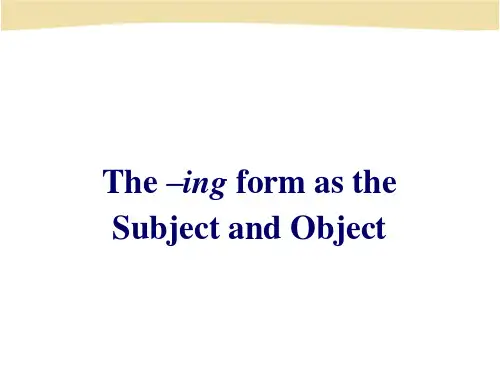
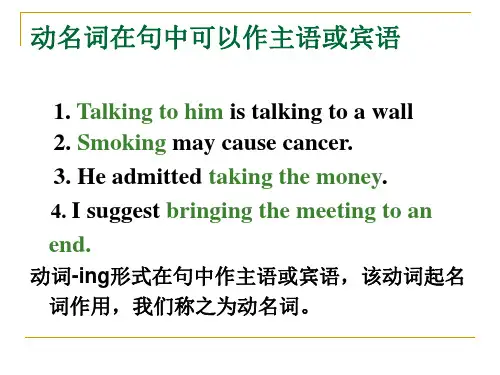
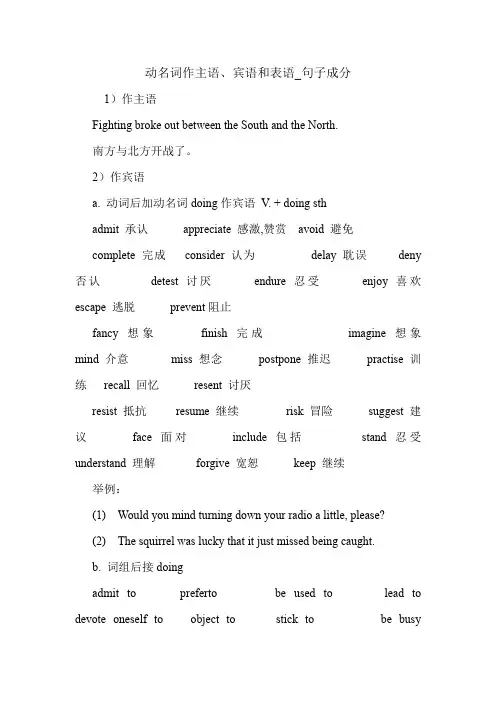
动名词作主语、宾语和表语_句子成分1)作主语Fighting broke out between the South and the North.南方与北方开战了。
2)作宾语a. 动词后加动名词doing作宾语V. + doing sthadmit 承认appreciate 感激,赞赏avoid 避免complete 完成consider 认为delay 耽误deny 否认detest 讨厌endure 忍受enjoy 喜欢escape 逃脱prevent阻止fancy 想象finish 完成imagine 想象mind 介意miss 想念postpone 推迟practise 训练recall 回忆resent 讨厌resist 抵抗resume 继续risk 冒险suggest 建议face 面对include 包括stand 忍受understand 理解forgive 宽恕keep 继续举例:(1)Would you mind turning down your radio a little, please?(2)The squirrel was lucky that it just missed being caught.b. 词组后接doingadmit to preferto be used to lead to devote oneself to object to stick to be busylook forward to to为介词)no good,no use,It’s worth,as well as,can’t help,It’s no use /good be tired ofbe fond of be capable of be afraid ofbe proud of think of / about hold offput off keep on insist on count on / uponset about be successful in good at take upgive up burst out prevent from3)作表语Her job is washing,cleaning and taking care of the children.。
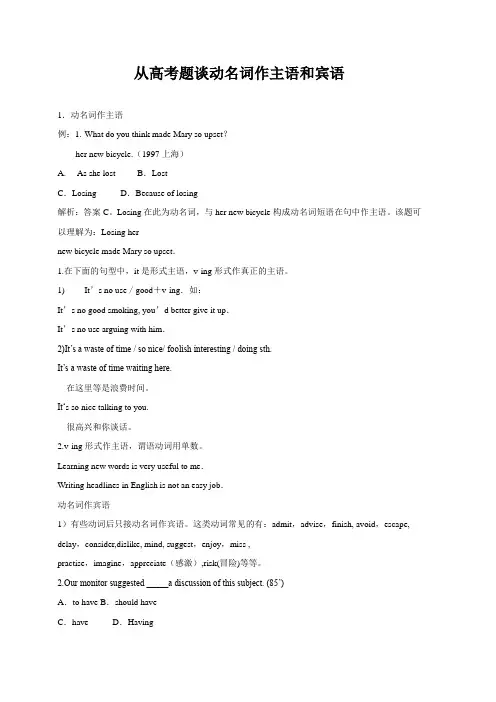
从高考题谈动名词作主语和宾语1.动名词作主语例:1.-What do you think made Mary so upset?-___ her new bicycle.(1997上海)A. As she lost B.LostC.Losing D.Because of losing解析:答案C。
Losing在此为动名词,与her new bicycle构成动名词短语在句中作主语。
该题可以理解为:Losing hernew bicycle made Mary so upset.1.在下面的句型中,it是形式主语,v-ing形式作真正的主语。
1) It’s no use/good+v-ing.如:It’s no good smoking, you’d better give it up.It’s no use arguing with him.2)It’s a waste of time / so nice/ foolish interesting / doing sth.It’s a waste of time waiting here.在这里等是浪费时间。
It‘s so nice talking to you.很高兴和你谈话。
2.v-ing形式作主语,谓语动词用单数。
Learning new words is very useful to me.Writing headlines in English is not an easy job.动名词作宾语1)有些动词后只接动名词作宾语。
这类动词常见的有:admit,advise,finish, avoid,escape, delay,consider,dislike, mind, suggest,enjoy,miss ,practise,imagine,appreciate(感激),risk(冒险)等等。
2.Our monitor suggested _____a discussion of this subject. (85’)A.to have B.should haveC.have D.HavingKey: D2)有些动词和动词词组既可接不定式也可接动名词作宾语,但意思不同。

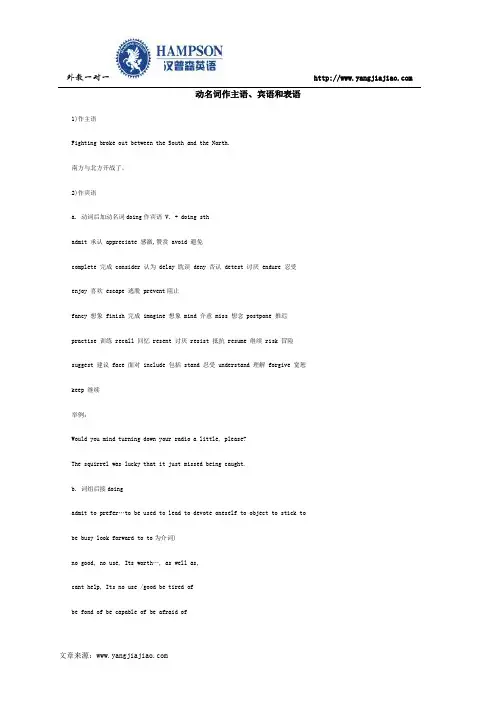
外教一对一动名词作主语、宾语和表语1)作主语Fighting broke out between the South and the North.南方与北方开战了。
2)作宾语a. 动词后加动名词doing作宾语 V. + doing sthadmit 承认 appreciate 感激,赞赏 avoid 避免complete 完成 consider 认为 delay 耽误 deny 否认 detest 讨厌 endure 忍受enjoy 喜欢 escape 逃脱 prevent阻止fancy 想象 finish 完成 imagine 想象 mind 介意 miss 想念 postpone 推迟practise 训练 recall 回忆 resent 讨厌 resist 抵抗 resume 继续 risk 冒险suggest 建议 face 面对 include 包括 stand 忍受 understand 理解 forgive 宽恕keep 继续举例:Would you mind turning down your radio a little, please?The squirrel was lucky that it just missed being caught.b. 词组后接doingadmit to prefer…to be used to lead to devote oneself to object to stick tobe busy look forward to to为介词)no good, no use, Its worth…, as well as,cant help, Its no use /good be tired ofbe fond of be capable of be afraid of外教一对一 be proud of think of / about hold offput off keep on insist on count on / uponset about be successful in good at take upgive up burst out prevent … from…3)作表语Her job is washing,cleaning and taking care of the children.。
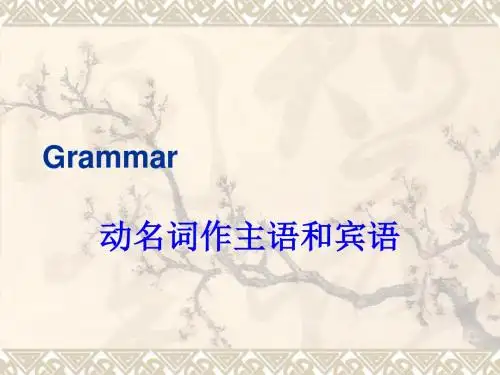
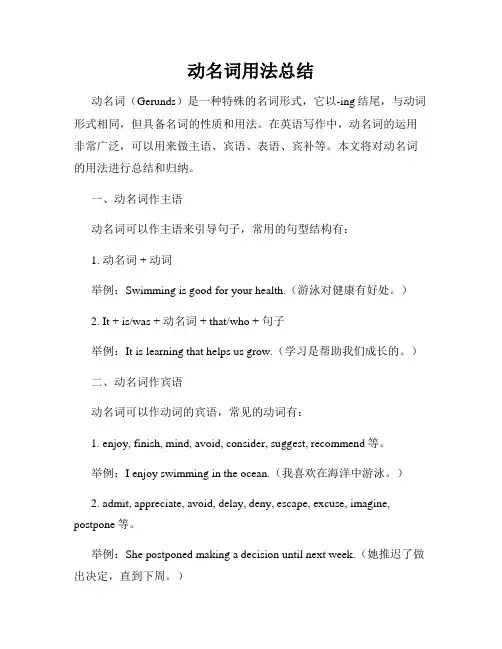
动名词用法总结动名词(Gerunds)是一种特殊的名词形式,它以-ing结尾,与动词形式相同,但具备名词的性质和用法。
在英语写作中,动名词的运用非常广泛,可以用来做主语、宾语、表语、宾补等。
本文将对动名词的用法进行总结和归纳。
一、动名词作主语动名词可以作主语来引导句子,常用的句型结构有:1. 动名词 + 动词举例:Swimming is good for your health.(游泳对健康有好处。
)2. It + is/was + 动名词 + that/who + 句子举例:It is learning that helps us grow.(学习是帮助我们成长的。
)二、动名词作宾语动名词可以作动词的宾语,常见的动词有:1. enjoy, finish, mind, avoid, consider, suggest, recommend等。
举例:I enjoy swimming in the ocean.(我喜欢在海洋中游泳。
)2. admit, appreciate, avoid, delay, deny, escape, excuse, imagine, postpone等。
举例:She postponed making a decision until next week.(她推迟了做出决定,直到下周。
)三、动名词作表语动名词可以作表语,常与be动词连用,表示主语的特征或状态。
举例:Her hobby is painting.(她的爱好是绘画。
)举例:My dream is traveling around the world.(我的梦想是环游世界。
)四、动名词作宾补在某些动词后面,可以加上动名词作宾补来表示动作的完整性。
常见的动词有:see, watch, hear, feel, notice, observe等。
举例:I saw him crossing the street.(我看到他穿过马路。
英语动名词有两个特点:1、它是从动词变化而来的,所以它保留了动词的某些特征,例如它能带自己的宾语、状语等,这时就叫动名词短语;2、顾名思义,动名词最大的特点是它相当于一个名词,因此,动名词可以在句中作主语、宾语等。
因为它作为名词来使用,所以动名词也有像名词一样的"所有格形式"。
1、作主语动名词是由动词变化而来,所以,动名词的意义往往是表示某个动作或某件事情。
例如:breathing became difficult at that altitude.在那个海拔高度呼吸变得很困难。
reading english aloud in the morning will do you a lot of good.早晨朗读英文会给你带来许多好处。
cheating on an exam ruins ones character.考试作弊毁坏人的性格。
it takes me ten minutes to get home from my office.我从办公室回家要花十分钟。
it needs time to make three copies of it.把它复制三份需要时间。
his being elected our chairman made us think of a lot.他当选为我们的主席使我们想起了许多许多。
动名词作主语时,对于一些比较长的动名词短语,一般采用"it is …"和"there is …"两种句式来表示。
例如:it is no use waiting for him any longer.等他是没有用的。
it is no good learning without practice.学而不实践是没好处的。
it is dangerous using this method to measure the speed of light.用这种方法去测量光速是危险的。
动名词的三种用法动名词是英语语法中的一种非常重要的语法形式,可以作为主语、宾语、定语、表语等,同时也可以用来表示一些特定的意义。
下面将介绍动名词的三种用法。
一、作主语动名词作主语时,通常表示某个具体的行为或状态,例如:- Swimming is my favorite hobby.(游泳是我最喜欢的爱好。
) - Reading books can broaden our knowledge.(读书可以拓宽我们的知识。
)二、作宾语动名词作宾语时,通常表示某个动作或行为的对象,例如:- I enjoy playing basketball.(我喜欢打篮球。
)- She hates doing housework.(她讨厌做家务。
)三、作定语动名词作定语时,通常表示修饰名词的一种方式,起到限定、具体化的作用,例如:- The running water in the river is very clear.(河中流动的水非常清澈。
)- The crying baby needs to be comforted.(哭泣的婴儿需要被安抚。
)除了以上三种常见的用法,动名词还可以表示一些特定的意义,例如:- V-ing + V-ed:表示同时或顺序进行的两个动作,如:He sat there, reading a book and drinking tea.(他坐在那里,一边看书一边喝茶。
)- V-ing + to-inf:表示动作的目的,如:He went there, hoping to meet his friend.(他去那里,希望能见到他的朋友。
)- V-ing + V-ing:表示两个动作同时进行,如:She was walking down the street, humming a song.(她一边走在街上,一边哼着歌。
)总之,动名词的用法非常丰富多样,对于英语学习者来说,掌握好动名词的使用,能够更加流利自如地表达自己的意思。
基础语法讲解动名词——动名词作主语、宾语和表语1)作主语。
例如:Fighting broke out between the South and the North. 南方与北方开战了。
2)作宾语a. 有些动词可以用动名词作宾语。
例如:例如:Would you mind turning down your radio a little, please? 你把收音机音量调小一点,好吗The squirrel was lucky that it just missed being caught. 这松鼠幸运得很,刚逃避了被逮住的厄运。
b. 有些结构后面可以用动名词作宾语或其他成分。
例如:3)作表语,对主语说明、解释。
例如:Her job is washing, cleaning and taking care of the children. 她的工作是洗刷、清扫和照顾孩子。
比较:She is washing, cleaning and taking care of the children.4)作定语,一般表示所修饰名词事物的用途。
例如:a writing desk=a desk for writing 写字台a swimming pool=a pool swimming 游泳池有些动名词作定语,与所修饰的名词关系比较复杂。
例如:boiling point=a temperature point at which something begins to boil 沸点a walking tractor=a tractor which a driver can operate while he or she is walking behind it 手扶拖拉机。
小学英语语法:动名词作主语、宾语和表语动名词作主语、动名词作宾语、动名词作表语1)作主语Fighting broke out between the South and the North.南方与北方开战了。
2)作宾语a. 动词后加动名词doing作宾语 V. + doing sthadmit 承认appreciate 感激,赞赏avoid 避免complete 完成 consider 认为 delay 耽误 deny 否认 detest 讨厌 endure 忍受enjoy 喜欢escape 逃脱 prevent阻止fancy 想象finish 完成 imagine 想象mind 介意 miss 想念 postpone 推迟practise 训练 recall 回忆 resent 讨厌resist 抵抗 resume 继续 risk 冒险suggest 建议face 面对 include 包括stand 忍受understand 理解 forgive 宽恕keep 继续举例:(1) Would you mind turning down your radio a little, please?(2) The squirrel was lucky that it just missed being caught.b. 词组后接doingadmit to prefer…to be used to lead to devote oneself to object to stick to be busy look forward to to为介词)no good, no use, It's worth…, as well as,can't help, It's no use /good be tired ofbe fond of be capable of be afraid ofbe proud of think of / about hold offput off keep on insist on count on / uponset about be successful in good at take upgive up burst out prevent … from…3)作表语Her job is washing,cleaning and taking care of the children.。
动名词作主语[考点导航]It’s necessary to be prepared for a job interview. _______ the answers ready will be of great help.A. To have hadB. Having hadC. HaveD. Having解析:答案为D。
Having the answers ready是动名词在句中作主语的用法。
【重点归纳】动名词是英语中动词的非谓语形式之一,起名词的作用,但是仍然保留动词的特性,可以有自己的宾语、状语等。
动名词作主语的主要用法如下:1. 动名词直接放在句首作主语。
如:Taking more exercise will keep you healthy.2. 动名词在“It is no use (no good, fun, a waste of time) 等+ 动名词”结构中作主语,it为形式主语。
如:It is no good writing to him; he never answers letters.It is no use complaining; the company won’t do anything about it.3. 动名词在“It is useless (nice, good, interesting, worthwhile) 等形容词+ doing”结构中作主语。
如:It is good having a walk after supper.4. 用于布告形式的省略结构中。
如:No smoking! (= No smoking is allowed!)5. 动名词的复合结构作主语。
如:有时可以在动名词前面加上一个名词或代词的所有格,构成动名词的复合结构,此时,该所有格作动名词的逻辑主语。
动名词的复合结构也可以在句中作主语。
如:Their coming to help was a great encouragement to us.动名词作宾语[考点导航]Susan wanted to be independent of her parents. She tried ____alone, but she didn’t like it and moved back home. (2008湖南卷)A. livingB. to liveC. to be livingD. having lived解析:答案为A。
动名词作主语和宾语
1.
注意:动名词的否定形式直接在它之前加not。
2.Detailed principles
①动名词做主语的用法(subject)
动名词做主语往往表示经常性、习惯性的动作,谓语动词用单数动词。
如:
__________(see) is believing. ____________(help) her is my duty.
__________ (eat)too much is bad for your health.
______________(work)with you is a pleasure.
动名词做主语和不定式做主语一样,也可以用it作形式主语。
如:
●It is useless trying to argue with Mark.
●It is no use talking with him.
归纳:常用-ing形式作主语的句型有:
●It be no use/useless doing 做……是没用的
●_____________________________________________
●_____________________________________________
●_____________________________________________
●……
eg:在这儿等没好处,我们走回家吧。
争辩此事是浪费时间。
要把一切按时准备好很困难。
②动名词作宾语的用法(object)
1.有些动词或短语后常用动名词作宾语。
如admit, appreciate, avoid, consider, suggest, allow, enjoy, escape, finish, imagine, practise, mind, miss, imagine等动词, insist on, keep on, give up, feel like, dream of, be/get used to, look forward to, devote…to, pay attention to等短语。
eg:你介意把门打开吗?(mind)
工作之余,袁隆平喜欢听小提琴曲。
(enjoy)
那个姑娘每晚练习拉小提琴。
(practise)
这些天他在考虑换工作。
(consider)
他承认犯了一个严重错误。
(admit)
今晚我想去看电影。
(feel like)
人们不断来医院看望他。
(keep on)
2.在allow, advise, permit等动词后直接跟动名词作宾语,如果这些词后有名词或代词作宾语,则构成“allow/advise/permit +名词/代词+不定式(宾语补足语)”之形式。
如:
We don't allow smoking here.
We don't allow anybody to smoke here.
3.有些动词和动词短语用it作形式宾语,而把真正的宾语——动名词放在后面。
常用的结构有:主语+ think/consider/find/…+ it useless/no use/no good/worthwhile/…+doing
e g: 我发现争论这件事没有用。
我认为不值得到这样一个地方去。
4.动词need, require, want意为“需要”时,后跟动名词的主动式或不定式的被动式作宾语,意义一样。
即need/require/want + doing = need/require/want + to be done. 如:Your shirt needs washing.
Your shirt needs to be washed.
这辆旧车需要修。
5.有些动词后跟动名词和跟不定式区别较大。
如:forget, go on, mean, remember, regret, stop, try, be used to, can't help等。
go on doing ________________ go on to do _________________
mean doing _________________ mean to do __________________
stop doing _________________ stop to do ____________
try doing____________________ try to do_________________
be used to doing______________ be used to do_________________
can't help doing ________________can't help to do____________________
regret doing_____________ regret to do___________________
eg: 我记得我已把信寄了。
我会记着去寄信的。
我永远不会忘记见到过那位著名作家。
不要忘了给你母亲写信。
我真后悔没赶上那次报告会。
我遗憾地告诉你我不能接受你的建议。